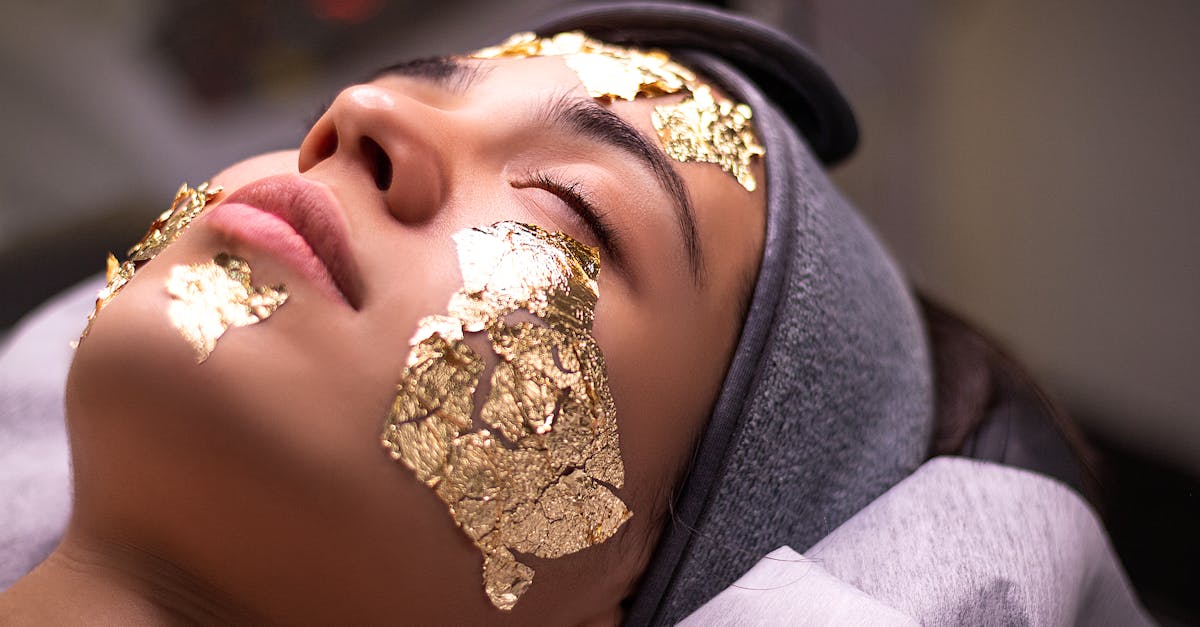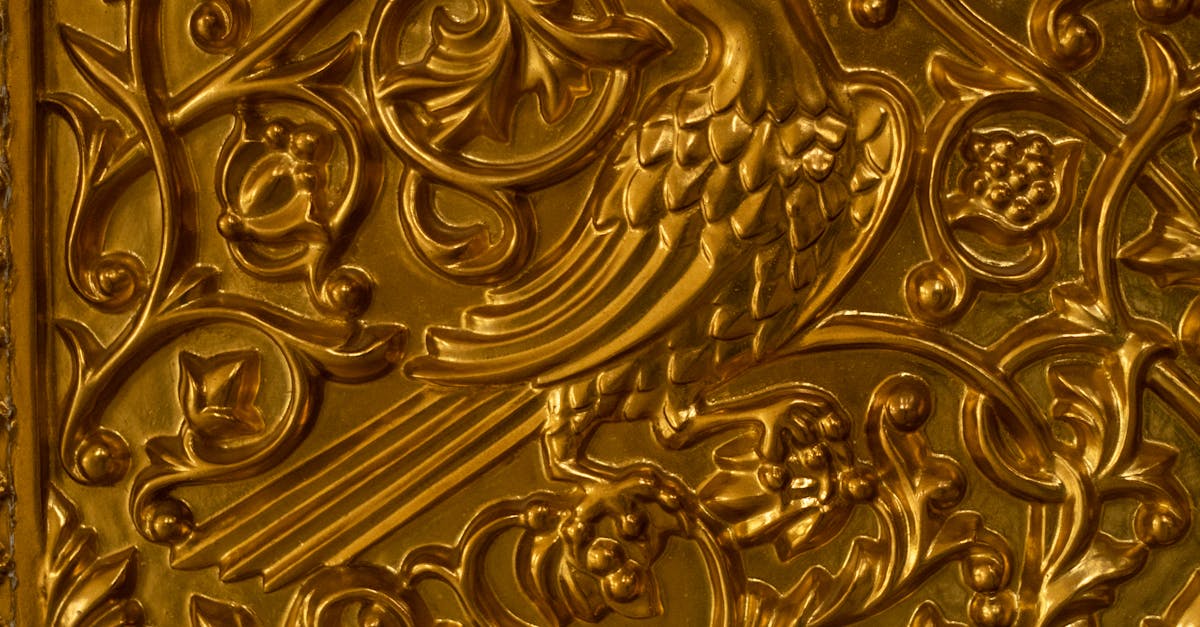Illuminating the Golden Thread: A Journey Through the Art and Allure of Gold Leaf

Embark on an illuminating journey into the captivating world of gold leaf, a material that has adorned civilizations for millennia. From its humble beginnings in ancient Egypt to its enduring presence in art, architecture, and design today, gold leaf continues to captivate with its opulent allure and remarkable versatility.
Throughout history, gold leaf has played a pivotal role in enhancing the beauty and significance of countless masterpieces. From the gilded domes of Byzantine churches to the intricate paintings of Renaissance masters, gold leaf has added a touch of radiance and grandeur to works of art that continue to inspire awe and wonder. In modern times, gold leaf is experiencing a resurgence in popularity as contemporary artists and designers push the boundaries of its creative potential, incorporating it into captivating installations, sculptures, and wearable art.
As we delve into the golden pages of history and explore the myriad applications of gold leaf, we will uncover the secrets behind its enduring charm and discover how this precious material continues to shape the landscape of art and design.
Key Insights
- Gold leaf is a versatile material that has been used for centuries to create beautiful and opulent works of art and design.
- Gold leaf is made from real gold, which gives it a unique set of properties, including malleability, reflectivity, and durability.
- Gold leaf is applied to a surface using an adhesive, and the process requires skill and precision.
- Gold leaf can be used to decorate a wide range of surfaces, including picture frames, furniture, and buildings.
- Gold leaf is a delicate material that requires careful care and maintenance.
1. The Golden Age: A Historical Perspective of Gold Leaf
Step into the golden annals of history and embark on a captivating journey through the evolution of gold leaf, a material that has captivated civilizations for millennia. Its origins can be traced back to ancient Egypt, where skilled artisans discovered the remarkable properties of gold and began using it to adorn tombs, temples, and artifacts. The Egyptians believed that gold possessed divine qualities and associated it with the sun god Ra, the giver of life. Gold leaf was meticulously applied to create shimmering surfaces that reflected the sun’s rays, illuminating sacred spaces and objects with an otherworldly glow.
As civilizations flourished and trade routes expanded, the art of gilding with gold leaf spread throughout the ancient world. In Mesopotamia, Persia, and Greece, gold leaf was used to embellish palaces, sculptures, and religious objects. The Greeks particularly revered gold for its association with the gods and goddesses of Mount Olympus. Gold leaf adorned temples, statues, and even the clothing of wealthy individuals, symbolizing power, status, and divine favor.
During the Middle Ages, gold leaf reached new heights of opulence in Byzantine art. Skilled Byzantine artisans developed innovative techniques for applying gold leaf to mosaics, icons, and architectural elements, creating breathtaking interiors that shimmered with golden light. The Byzantine Empire’s influence extended throughout Europe, and the use of gold leaf became widespread in religious art, particularly in the creation of illuminated manuscripts and altarpieces. Gold leaf was also employed in secular contexts, adding a touch of luxury to palaces, castles, and the homes of the wealthy.
2. Beyond Adornment: Unveiling The Diverse Applications of Gold Leaf

Beyond its traditional role in adorning sacred spaces and objects, gold leaf has found myriad applications in art, architecture, and design throughout history. Its versatility and aesthetic appeal have made it a beloved material for embellishing diverse surfaces, from grand architectural structures to delicate crafts. In architecture, gold leaf has been used to create awe-inspiring interiors and exteriors. Byzantine churches, such as the Hagia Sophia in Istanbul, feature intricate gold leaf mosaics that shimmer with golden light, creating a sense of ethereal splendor. In Renaissance Europe, gold leaf was applied to domes, ceilings, and altars, adding a touch of opulence and grandeur to religious and secular buildings alike.
Gold leaf has also been широко used in painting and sculpture. Medieval and Renaissance artists incorporated gold leaf into their works to represent divine light and celestial beings. Gold leaf backgrounds in religious paintings created a sense of heavenly radiance, while gilded sculptures added a touch of majesty and realism. In modern times, artists such as Gustav Klimt and Egon Schiele used gold leaf to create shimmering, ethereal effects in their paintings. Sculptors have also employed gold leaf to enhance the beauty and significance of their works, from ancient Greek statues to contemporary installations.
In addition to its use in fine art, gold leaf has also been incorporated into intricate crafts and modern design. Japanese artisans have used gold leaf to create stunning lacquerware and ceramics, while Indian craftsmen have employed it in intricate jewelry and textiles. In modern design, gold leaf has been used to add a touch of luxury and sophistication to everything from furniture and lighting to fashion and accessories. Its versatility and timeless appeal continue to inspire artists and designers to explore its creative potential in new and innovative ways.
3. Crafting Opulence: A Step-by-Step Guide to The Gilding Process
Embark on a journey into the world of gilding, an ancient and meticulous craft that transforms ordinary surfaces into shimmering works of art. Gilding involves applying gold leaf to a prepared surface, creating a luxurious and opulent effect. While the process may seem daunting, it can be mastered with patience and careful attention to detail. The first step in gilding is to prepare the surface. This involves cleaning and smoothing the surface to ensure that it is free of any dirt, grease, or imperfections. The surface should then be coated with a layer of gesso, a traditional priming material that provides a smooth and absorbent base for the gold leaf.
Once the gesso is dry, the next step is to apply adhesive to the surface. Traditionally, water-based adhesives such as rabbit skin glue or gelatin were used, but modern acrylic adhesives are also suitable. The adhesive should be applied evenly and thinly to the surface, using a soft brush or sponge. It is important to allow the adhesive to become tacky before applying the gold leaf, as this will ensure a strong bond. The final step is to apply the gold leaf itself. Gold leaf is extremely thin and delicate, so it must be handled with care. It can be applied using a gilding brush, tweezers, or a special leafing tool. The gold leaf is gently pressed onto the adhesive surface, and any excess leaf is brushed away.
Gilding is a rewarding process that can transform ordinary objects into extraordinary works of art. With patience and practice, you can master the techniques of gilding and create beautiful and opulent pieces that will be treasured for generations to come.
4. A Canvas of Centuries: Exploring Masterpieces Gilded with Gold Leaf

Throughout history, gold leaf has been used to adorn some of the world’s most iconic works of art, adding a touch of opulence and grandeur to paintings, sculptures, and other objects. These masterpieces have stood the test of time, captivating audiences with their beauty and historical significance. One of the most famous examples of gold leaf in art is Gustav Klimt’s painting, “The Kiss.” Klimt used gold leaf to create the shimmering background of the painting, which adds to the sense of intimacy and romance between the two figures. The gold leaf also helps to emphasize the intricate patterns and details of their clothing and surroundings.
Another iconic work of art that features gold leaf is the Ghent Altarpiece by Jan van Eyck. This 15th-century masterpiece is a multi-paneled altarpiece that depicts scenes from the life of Christ. Van Eyck used gold leaf to create the gilded frames around the panels, as well as to decorate the robes of the figures and the background of the paintings. The gold leaf adds a sense of richness and splendor to the altarpiece, and helps to draw the viewer’s attention to the central figures and events.
Gold leaf has also been used to create stunning sculptures. One example is the Golden Buddha of Wat Traimit in Bangkok, Thailand. This massive statue is made entirely of gold leaf, and weighs over five tons. The gold leaf gives the statue a radiant and otherworldly appearance, and it is considered to be one of the most sacred objects in Thailand. These are just a few examples of the many masterpieces that have been adorned with gold leaf throughout history. These works of art continue to inspire and amaze viewers with their beauty and craftsmanship, and they serve as a testament to the enduring power of gold leaf as an artistic medium.
5. The Alchemy of Gold: Understanding The Properties and Characteristics of Gold Leaf
Gold leaf possesses a unique set of properties and characteristics that have made it a prized material for centuries. Its malleability, reflectivity, and durability make it ideal for a wide range of applications, from art and architecture to jewelry and fashion. Gold leaf is extremely thin, typically measuring only a few microns in thickness. This makes it highly malleable, allowing it to be easily shaped and applied to various surfaces. Its malleability also contributes to its versatility, as it can be cut, torn, or embossed to create intricate designs and patterns.
Gold leaf is also highly reflective, meaning that it has the ability to reflect light and create a shimmering, metallic effect. This property makes it an excellent choice for gilding, as it can add a touch of opulence and glamour to any object. Gold leaf’s reflectivity also contributes to its durability, as it is resistant to tarnishing and corrosion. This makes it an ideal material for both indoor and outdoor applications, as it can withstand exposure to the elements without losing its luster.
In addition to its malleability, reflectivity, and durability, gold leaf is also a relatively inert material. This means that it is not easily affected by chemicals or other environmental factors, making it a stable and long-lasting material. Gold leaf’s unique properties make it a valuable material for a wide range of applications. It is used in art and architecture to create stunning and opulent works, and it is also used in jewelry, fashion, and other industries to add a touch of luxury and glamour.
6. The Midas Touch: Preserving and Restoring Gilded Artifacts
Preserving and restoring gilded artifacts requires specialized techniques and expertise to ensure that these precious objects are maintained for future generations. Conservators use a variety of methods to clean, repair, and protect gold leaf, depending on the condition of the artifact and the materials used. One of the most important steps in the conservation process is to clean the gold leaf. This is done using gentle cleaning solutions and soft brushes to remove dirt, dust, and other surface contaminants without damaging the delicate gold leaf. Conservators may also use specialized techniques to remove tarnish or corrosion from the gold leaf, such as chemical reduction or electrochemical cleaning.
Once the gold leaf has been cleaned, conservators may need to repair any damage or tears. This can be done using a variety of techniques, such as applying new gold leaf to fill in missing areas or using a specialized adhesive to bond torn pieces back together. Conservators also use techniques such as inpainting to match the color and texture of the new gold leaf to the existing gold leaf, ensuring a seamless repair. In some cases, it may be necessary to remove and reapply the gold leaf if it is severely damaged or if the underlying surface needs to be repaired.
Once the gold leaf has been repaired, conservators will apply a protective coating to help prevent future damage. This coating can be made from a variety of materials, such as varnish, wax, or acrylic resin. The type of coating used will depend on the specific artifact and the environment in which it will be displayed. Conservators take great care to ensure that the protective coating does not alter the appearance of the gold leaf or interfere with its ability to reflect light.
7. A Golden Legacy: The Future of Gold Leaf in Art and Design
Gold leaf continues to inspire and captivate artists and designers in the modern era, who are pushing the boundaries of this ancient material in innovative and exciting ways. Contemporary artists are using gold leaf to create thought-provoking sculptures, installations, and paintings that explore themes of luxury, opulence, and the passage of time. One artist who has made significant contributions to the contemporary use of gold leaf is Anish Kapoor. Kapoor’s works often explore the relationship between the physical and the spiritual, and he has used gold leaf to create shimmering, reflective surfaces that evoke a sense of awe and wonder.
In the realm of design, gold leaf is being used to add a touch of luxury and glamour to everything from furniture and lighting to fashion and accessories. Designers are also experimenting with new techniques for applying gold leaf, such as using it to create intricate patterns or to cover entire surfaces. One designer who is known for her innovative use of gold leaf is India Mahdavi. Mahdavi’s work is characterized by its bold use of color and pattern, and she has used gold leaf to create stunning furniture and lighting that is both luxurious and playful.
The future of gold leaf is bright, as artists and designers continue to find new and innovative ways to use this ancient material. Gold leaf’s unique properties of malleability, reflectivity, and durability make it an ideal material for creating stunning and memorable works of art and design. As we move into the future, we can expect to see even more exciting and innovative uses of gold leaf in the years to come.
What is the difference between gold leaf and gold paint?
Gold leaf is a thin sheet of real gold that is applied to a surface using an adhesive. Gold paint, on the other hand, is a paint that contains gold particles. Gold leaf is more expensive than gold paint, but it is also more durable and has a more luxurious appearance.
How do you apply gold leaf?
Gold leaf is applied to a surface using an adhesive. The surface must first be prepared by cleaning it and applying a layer of gesso. Once the gesso is dry, the adhesive is applied to the surface and the gold leaf is carefully laid on top. The gold leaf is then burnished to smooth out the surface and remove any wrinkles.
What are some of the different uses of gold leaf?
Gold leaf is used in a variety of applications, including art, architecture, and design. It is often used to decorate picture frames, furniture, and other objects. Gold leaf is also used in the restoration of historic buildings and artifacts.
How do you care for gold leaf?
Gold leaf is a delicate material that requires careful care. It should be cleaned with a soft, dry cloth. Avoid using harsh chemicals or abrasives, as these can damage the gold leaf.
Table of Key Insights
| Key Insight | Description | |—|—| | Gold leaf is a versatile material that has been used for centuries to create beautiful and opulent works of art and design. | Gold leaf can be used to decorate a wide range of surfaces, including picture frames, furniture, and buildings. | | Gold leaf is made from real gold, which gives it a unique set of properties, including malleability, reflectivity, and durability. | These properties make gold leaf ideal for use in a variety of applications, including art, architecture, and design. | | Gold leaf is applied to a surface using an adhesive, and the process requires skill and precision. | The application of gold leaf is a delicate process that requires careful attention to detail. | | Gold leaf can be used to decorate a wide range of surfaces, including picture frames, furniture, and buildings. | Gold leaf can be used to add a touch of luxury and elegance to any object. | | Gold leaf is a delicate material that requires careful care and maintenance. | Gold leaf is a valuable material that should be cared for properly to ensure its longevity. |